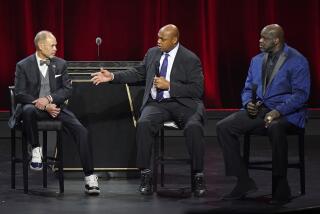Pay TV’s full-court press
If you live in the Los Angeles area and are not a sports fan, Time Warner Cable’s new 20-year deal with the L.A. Lakers is going to hurt you where it counts: in your wallet. That’s because virtually all digital pay-TV subscribers in the L.A. area, whether or not they are sports fans, will foot the bill for this expensive deal. The Time Warner-Lakers agreement is just the latest example of how a small set of sports channels has become a key driver of the escalating amount we are all paying to watch television.
Increasingly, those who don’t watch sports are nonetheless subsidizing expensive sports broadcasts. To get a sense of how significant these subsidies are nationwide, consider this: A small cluster of sports-oriented cable channels (ESPN and its sister networks; TNT, which carries NBA games; and applicable regional sports networks that specialize in local teams) now accounts for about $10 per month in pay-TV operators’ licensing costs. When marked up for retail distribution, the result is that about $15 — or 25% of the $60 a month or so that an average subscriber pays — is going solely to cover the underlying cost of sports-oriented networks.
Let’s assume, for purposes of argument, that 20% of the country’s roughly 83 million digital households fall into this non-fan or casual fan bucket. That’s 16.6 million subscribers paying somewhere in the neighborhood of $15 a month for sports channels they don’t really want or watch, bringing the annual subsidy to nearly $3 billion.
How has it come to this? Because sports network owners have been brilliant at contractually mandating pay-TV operators to carry these networks — which are by far the most expensive to license — on their most-popular digital TV tiers, where they are bundled with a hodgepodge of other specialty cable networks.
For pay-TV operators, mindful of online video alternatives such as Netflix and Hulu Plus, live sports is increasingly viewed as a key defense against “cord-cutting” — abandoning pay TV for online and other alternatives. Now Time Warner Cable, a pay-TV operator itself, is looking to capitalize on this by creating two regional sports networks, one in English and one in Spanish, around the marquee Lakers, beginning with the 2012 season. Time Warner Cable reportedly paid $3 billion for the rights, which would mean $150 million a year in fees to the Lakers.
For Time Warner Cable, which controls about 40% of pay-TV homes in the L.A. market, the key to making the Lakers deal work is getting the other pay-TV operators in the L.A. market to carry the new channels on their most popular digital tiers. Time Warner will demand top dollar for the two Lakers networks, possibly more than $3 a subscriber a month. This will in turn put pressure on these other operators to raise their rates to cover their increased costs.
The whole thing poses a dilemma for pay-TV operators. They will be hard-pressed competitively not to carry the Lakers’ networks, but they’ll also worry that higher rates will drive up cord-cutting. As L.A.-area pay-TV rates escalate, inevitably some non-sports fans or casual fans will be prompted to scrutinize their viewing behavior and monthly bills and conclude the value of pay-TV just isn’t there any longer. When the most common digital TV tier soars past $70 or $80 a month — before add-ons like DVR, VOD, multiple set-top box rentals and other services — the appeal of cord-cutting will rise.
Compounding things, for tech-savvy, Internet-centric consumers, paying for anything not used or valued is fast becoming a vestige of another age. Sports is unlikely to be an exception to consumers’ new rules of value assessment. Hard-core fans will probably suck it up and pay. But for the less sports-minded among us, and especially for those who are already shifting their viewership to services like Netflix and Hulu Plus, deals like the one between Time Warner Cable and the Lakers may be the final impetus to drop pay-TV entirely.
Sports programming has huge value for sports fans, but expecting endlessly higher subsidies from non-fans and casual fans is no slam-dunk.
Will Richmond is an online video industry analyst with VideoNuze, which covers the online and mobile video sectors.
More to Read
A cure for the common opinion
Get thought-provoking perspectives with our weekly newsletter.
You may occasionally receive promotional content from the Los Angeles Times.






